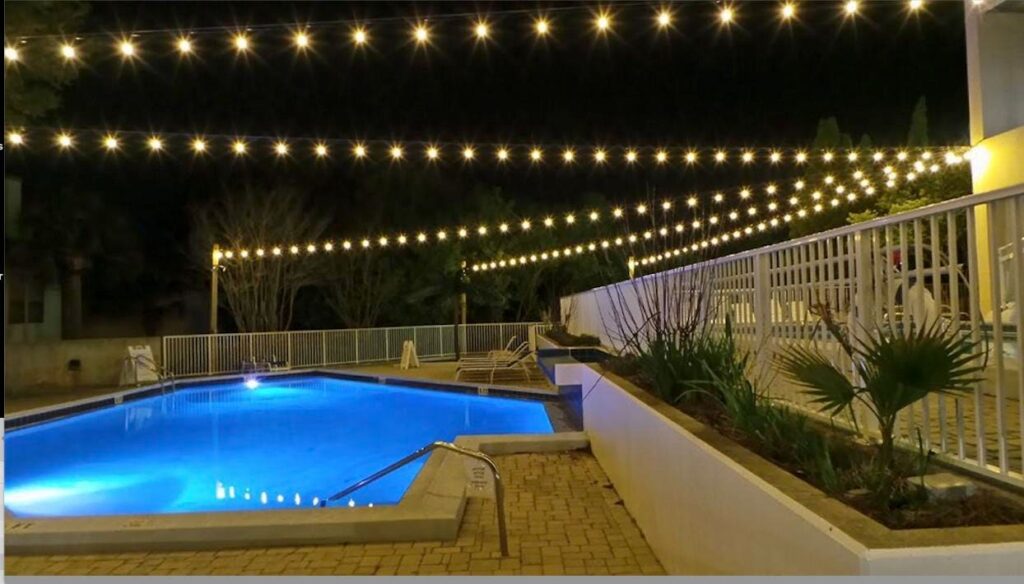Whether you’re creating curb appeal or celebrating the year of the backyard by creating a great outdoor entertaining hub, outdoor lighting plays a crucial part. “There are amazing things that can be done with landscape lighting, but it can be costly to put in the infrastructure,” says Annie Obermann, co-founder and principal designer at Forge & Bow. “String lights are a great option to cover a larger area and you can install them with an outlet and a few well-placed trees or landscape posts.”
But whether it’s a small or a large outdoor lighting project, some mistakes can ruin the vibe, and may cause safety issues as well.
Mistake #1: You Have Too Many Or Too Few Lights
A helter-skelter approach probably won’t produce the desired result. According to Kyle Beach, COO of Wonderly Lights, planning and placement are crucial. “Create a cohesive lighting design that avoids harsh hotspots or dark voids, think in terms of visual balance and even distribution of light across the space,” he explains. Too much lighting can be harsh and kill the ambiance, but if you don’t have enough lighting, Beach says it can be unwelcoming and unsafe.
However, there’s an easy fix for this problem. Start with a lighting plan. “Think like a designer and map out your space and decide the best layout for lighting,” Beach says. For example, do you want to uplight a tree canopy for dramatic effect? Do you want to string bistro lighting? “Techniques like moonlighting, wall grazing, silhouetting, and zone-based lighting can all be used to create a beautiful backyard,” he says.
Beach recommends layering the lighting. “When you mix different types of lighting—uplights for trees, path lights for walkways, string lights to create social areas and spotlights for focal points – it adds depth and dimension,” he says. Also, if you vary the wattage of your lamps, Beach notes that you can add depth and dimension.
Mistake #2: Using The Wrong Materials
Selecting the wrong transformers, fixtures, and bulbs or lamps could result in a variety of Aproblems, including overheating, fire hazards, and corrosion.
However Beach says there’s any easy solution to avoid this mistake as well. “Always select fixtures, bulbs, and connectors labeled for outdoor use (look for ‘wet-rated
or ‘weather-resistant’),” he says. These items are built to handle rain, humidity, and temperature fluctuations. “Make sure your transformer is properly sized to support the total wattage of your system with some room to grow,” Beach says, warning that an undersized transformer could lead to dimming, short circuits, or system failure.
The expert tip for this section: Beach recommends using low-voltage LED bulbs since they are energy-efficient, produce less heat, and have a longer lifespan. “Make sure the wattage doesn’t exceed the fixtures’ maximum rating,” Beach says. “Typical color temperatures include 2700K for a warm, classic look, and 3000K for a slightly brighter, more modern appearance.”
Mistake #3: Poor Installation
DIY lighting might appear to be a good way to save money. However, Beach warns that DIYers don’t always know the best safety installation practices.
To ensure safety, the easy fix for this problem is to use low-voltage lighting systems. “Bury wires 6 inches deep or use conduit and seal all connections with waterproof gel-filled wire nuts or shrink-wrap tubing,” Beach advises. Also, be sure to follow the manufacturer’s specs for maximum run length and load capacity.
Beach provides 4 expert tips:
#1: Avoid anchoring to trees, especially living limbs, as movement and growth can damage the lights or the tree.
#2: Use permanent anchor points like buildings, pergolas, or poles secured in concrete or heavy planters.
#3: Run a tensioned cable (aircraft cable or stainless steel wire) between anchor points, then attach string lights to that for extra support and cleaner lines.
#4: Use outdoor-rated mounting hardware like screw hooks or eye bolts, and check periodically for wear or loosening.
In addition, Beach recommends being intentional about fixture placement. “Choose the right fixture for the right location by considering how the space is used,” he says. For instance, uplights and path lights should be placed in flower beds or areas that aren’t regularly mowed— Beach says that installing them in grass can lead to damage from lawn equipment.
Outdoor Lighting Part 2 is packed with practical lighting tips and tracks.
Read the full article here

